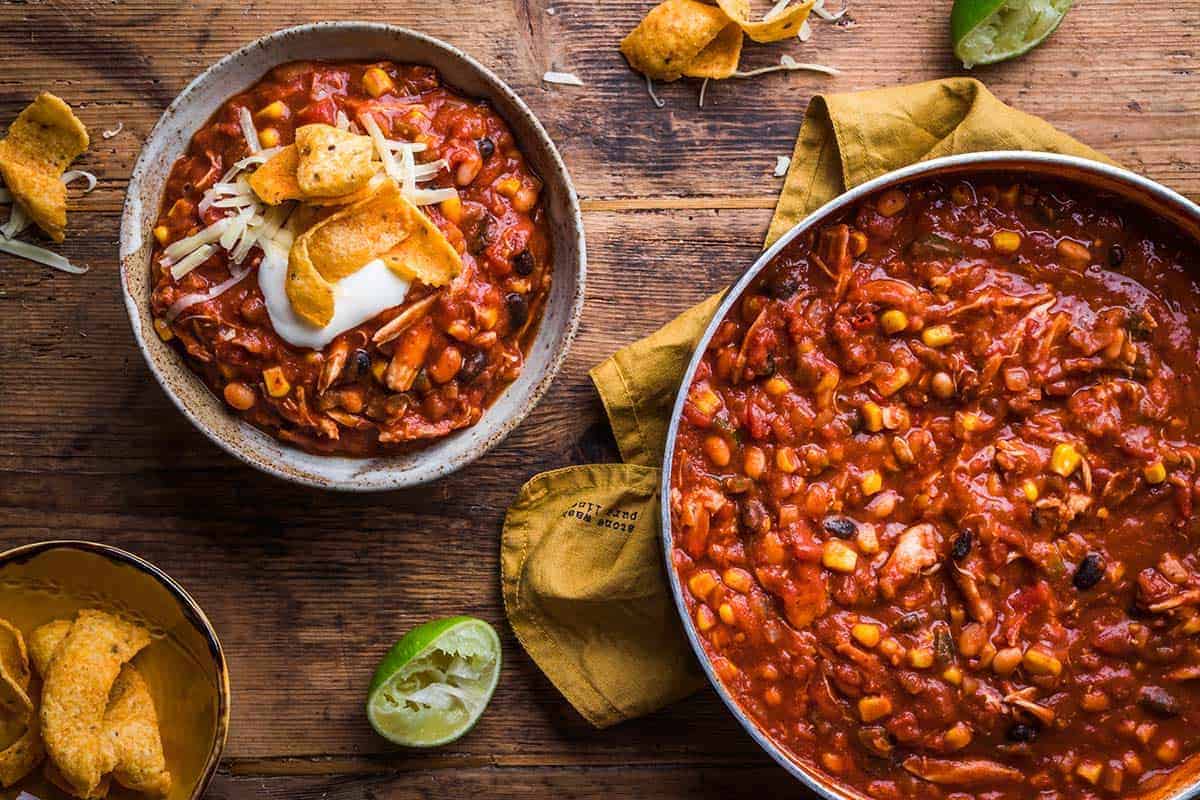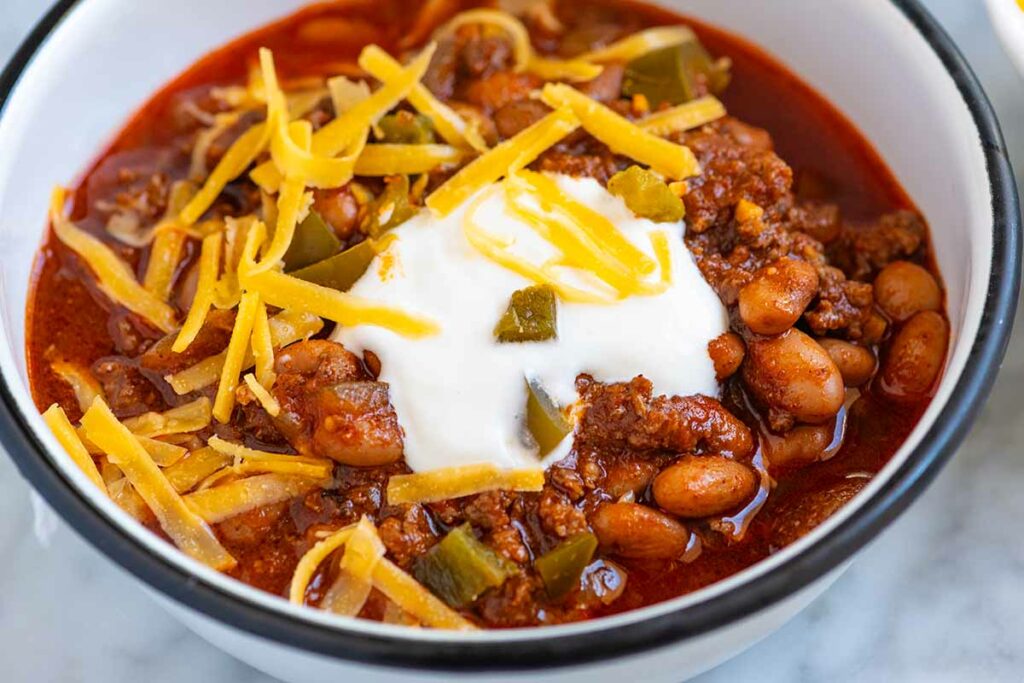
A classic American dish with Mexican roots in it, Chili varies in taste and texture from place to place. Proudly wearing the richness of history and a blend of spices, Chili has seized the hearts of people around the world. There are many reasons why it remains adored as an iconic dish and comfort food at the same time.
Chili for you is how it is prepared and what the ingredients used are. It has that versatile quality to be adapted to any dietary preferences if it is prepared wisely. Be mindful of the ingredients added, so that you can make a nutritious, balanced meal or a low-healthy one with all your comfort toppings.
What is Chili?
Chili, also known as ‘Chili con carne’, is a stew or soup, that typically consists of meat, beans, various spices, and seasonings in it. It is famous for its diverse flavors and variety of preparations worldwide. Well, if you love to have it in your way, it would be different in taste and texture, no doubt!
The commonly added toppings are cheese, sour cream, chopped onion, etc. The meat used here is often beef, and recipes are using all kinds of ground meat too. It can be made in countless ways, excluding meat, but with beans, vegetables, etc. for the vegetarian in you.
Chili in Different Countries
When you ask, where does chili come from? There would be no exact answer about the origin. It can be traced back to America, particularly in the American Southwest, Texas, by the 20th century. Moreover, it was influenced by the Spanish, Mexican, and many others. It was popular among the Cowboys early, made with beef, chili peppers, and spices.
The Spanish frontiers were the ones who added cumin, garlic, and onions to the Chili that is familiar to you now. Texans simply made it with beef and chili peppers, and it traditionally does not contain beans. They gave it a thick texture with a richness of spicy flavor.
When it comes to Ohio, a unique sweet, and tangy version of chili is served with spaghetti, topped with cheese and onions. It is made without following the traditional way of making chili, including cocoa, cinnamon, and cloves.
There is another one, New Mexican Chili, which uses green and red chile in different forms in the stew. And the level of spiciness can be medium to extreme as per taste preferences. The varieties are not only in the ingredients but also in the flavor, as there are chilies that have earthy and smoky flavors, just like the Southwestern chili.
A vegan version of chili is becoming trendy in many parts of the country which promotes the use of plant proteins and vegetable proteins by adding beans, lentils, etc. In some areas, people add seafood to chili meals, resulting in different varieties of chili.
Besides this, there are chilies with a creamy texture, barbecue-flavored and sweet-flavored, and many more across the world, and it becomes unique, as the individual who prepares it. In some places, the only difference is in the name, but in others, only a common ingredient is there which stimulates the taste buds.

Calories Per Serving
A typical homemade chili made with ground beef can contain approximately 350 to 450 calories per cup, and if it is 100 grams, then you can expect 159 calories and 12.8 grams of protein. But yes, these caloric counts may vary depending on the ingredients used to prepare and certain factors like the type of meat, vegetables, toppings added like cheese and cream, etc.
The calorie count is best managed when you opt for a nutritional and detailed recipe in every possible way. Furthermore, chili offers a low amount of carbohydrates and sugar, making it a good option for a diet plan.
How it is Made?
Though there are a hundred ways to prepare chili, the one popular and classic way, and followed by many restaurants and people, is with ground beef and beans. It is usually made in a large pot, where diced onion, corn, and bell pepper, along with garlic are added and sautéed until they become soft.
Then add spices like cumin, pepper, oregano, and spices of your wish and mix it. Next, you can add the meat or vegetables of your choice and mix it for another 2 minutes. Now add diced tomatoes, broth, and beans if you want. Mix to combine all the ingredients.
Reduce the heat and bring it to a simmer. Cook it for about 30 minutes and stir occasionally. Taste the mix and adjust the spices according to your preferences. Once it reaches your taste and consistency, it is ready to serve. Serve in bowls and garnish it with cheese, onions, or anything of your choice.
Spices and Seasonings in Chili

Chili is known for its exclusive taste along with the spices and seasonings added. There are many spices that we can add to make a unique, personalized cup of meal. But the most commonly added are, cumin, chili powder, paprika, garlic, onion, Mexican oregano, black pepper, and bay leaves.
Turmeric, cinnamon, cocoa powder, and fenugreek, can all give an unexpected twist and flavor to your cup of chili. The only limitation in adding spices to chili is your preferences. Yes! Whatever find appealing to you, just add it and make your unique chili recipes, and enjoy experimenting with the taste.
Health benefits of Chili
Chili, like any other food when consumed in moderation considering the diet, offers many health advantages.
Boosts Metabolism: It helps boost metabolism as it contains Capsaicin, which helps in increasing the metabolism rate resulting in burning calories and weight management.
Antioxidants and vitamin C: Being a powerful source of antioxidants, it protects you from many lifestyle diseases and stomach ulcers. Also supports the immune system and health. Adding more vegetables increases the fiber content and antioxidant properties of chili.
Weight loss: As the metabolic rate increases, it may contribute to weight management along with burning calories. Capsaicin helps burn fat, which can also be advantageous to weight loss.
Healthy heart: Choosing ground beef for your cup of beef chili may help in heart health because the fat content in ground beef is lower in amount.
Dietary Preferences
Chili is known for the meat varieties added to it, but it can be satisfying for both vegans and vegetarians. Some dietary considerations are:
Vegans
Add more plant proteins such as beans, kidney beans, black beans, lentils, etc. which can provide the exact amount of protein in meat-based chili. You can even add vegetables like corn, mushrooms, etc. to add flavor. Vegetable broth along with dairy-free cheese, plant-based cream, etc. can also be added as toppings.
Vegetarians
For vegetarians, dairy products and egg-based ingredients can be added for protein content. You can use shredded cheese, yogurt, cream, etc. as toppings. Fried eggs are a good option for topping, and it is practiced in certain regions.
Is Chili Gluten-Free?
The key ingredients in chili, such as meat, beans, vegetables, and spices, are all gluten-free. But certain toppings like soy sauce, corn flour, or any other thickening agent may contain gluten. Therefore, you can opt for a gluten-free chili by ensuring the ingredients and preparation method are free of gluten.

Common Allergens in Chili
The recipe you prepare decides the presence of allergens in your meal. Some of the common allergens are:
Soy
Peanuts
Dairy
Gluten
Fish
Shellfish
The allergens vary for different individuals. It is your responsibility to avoid accidental exposure to the allergens by ensuring that the allergen is not included in your meal.
Frequently Asked Questions(FAQ’s)
It can be spicy, sweet, and tangy depending on the ingredients used to prepare. But often it has that rich, savory profile.
A traditional chili includes ground beef, chili peppers, tomatoes, spices, and garlic. If it is for a vegetarian, you can add beans and vegetable broth. Ingredients may change according to the region.
If you are having chili with ground beef or vegetables, low-added salts, and fat, it can be a nutritional meal. Keep in mind that, whether chili is healthy or not completely depends on the way it is prepared and served.
For long-term use, chili can be frozen. Also, you can keep it for 3 to 4 days in the refrigerator in an airtight container.